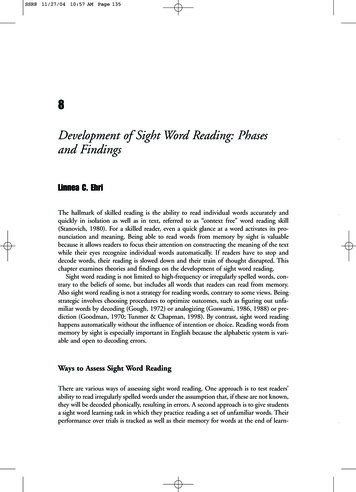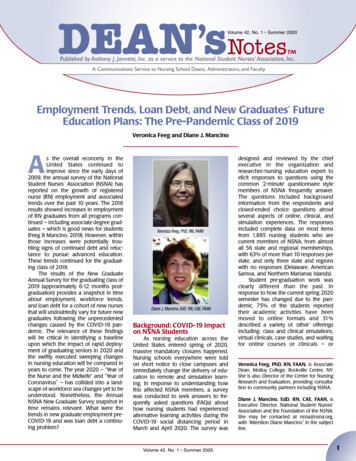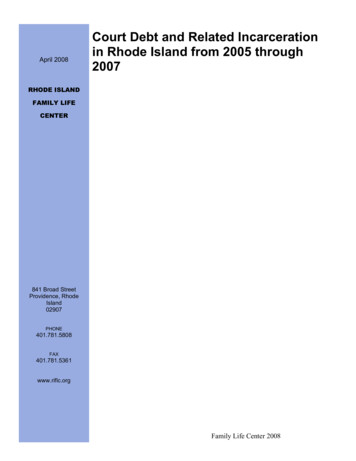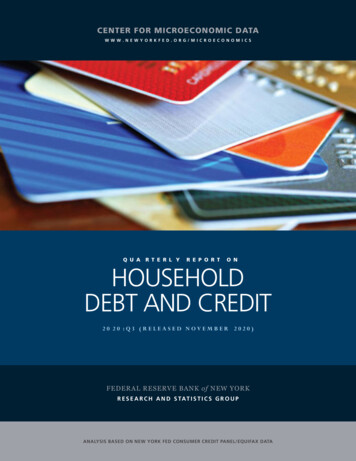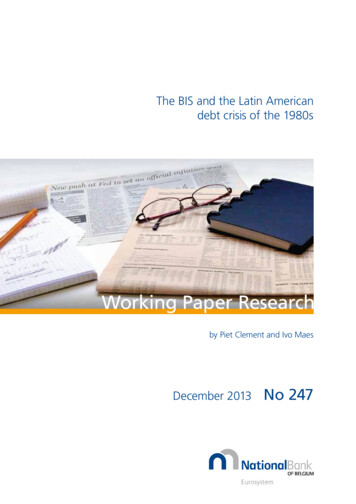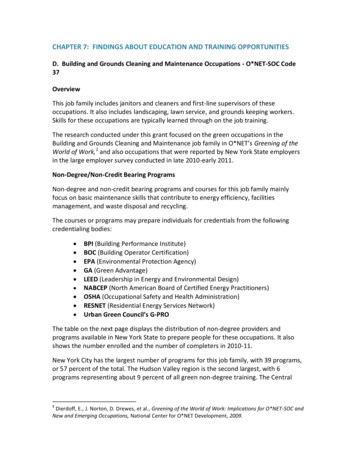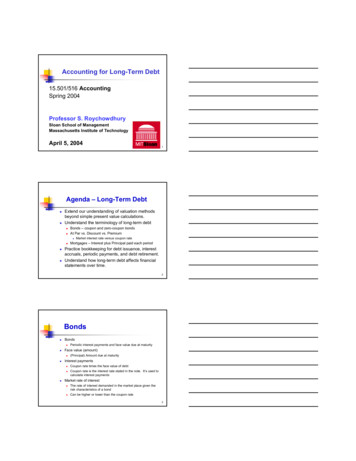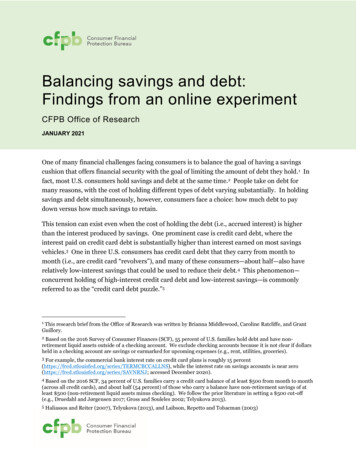
Transcription
Balancing savings and debt:Findings from an online experimentCFPB Office of ResearchJANUARY 2021One of many financial challenges facing consumers is to balance the goal of having a savingscushion that offers financial security with the goal of limiting the amount of debt they hold.1 Infact, most U.S. consumers hold savings and debt at the same time.2 People take on debt formany reasons, with the cost of holding different types of debt varying substantially. In holdingsavings and debt simultaneously, however, consumers face a choice: how much debt to paydown versus how much savings to retain.This tension can exist even when the cost of holding the debt (i.e., accrued interest) is higherthan the interest produced by savings. One prominent case is credit card debt, where theinterest paid on credit card debt is substantially higher than interest earned on most savingsvehicles.3 One in three U.S. consumers has credit card debt that they carry from month tomonth (i.e., are credit card “revolvers”), and many of these consumers—about half—also haverelatively low-interest savings that could be used to reduce their debt.4 This phenomenon—concurrent holding of high-interest credit card debt and low-interest savings—is commonlyreferred to as the “credit card debt puzzle.”51This research brief from the Office of Research was written by Brianna Middlewood, Caroline Ratcliffe, and GrantGuillory.2Based on the 2016 Survey of Consumer Finances (SCF), 55 percent of U.S. families hold debt and have nonretirement liquid assets outside of a checking account. We exclude checking accounts because it is not clear if dollarsheld in a checking account are savings or earmarked for upcoming expenses (e.g., rent, utilities, groceries).3For example, the commercial bank interest rate on credit card plans is roughly 15 CALLNS), while the interest rate on savings accounts is near zero(https://fred.stlouisfed.org/series/SAVNRNJ; accessed December 2020).4Based on the 2016 SCF, 34 percent of U.S. families carry a credit card balance of at least 500 from month to month(across all credit cards), and about half (54 percent) of those who carry a balance have non-retirement savings of atleast 500 (non-retirement liquid assets minus checking). We follow the prior literature in setting a 500 cut-off(e.g., Druedahl and Jørgensen 2017; Gross and Souleles 2002; Telyukova 2013).5Haliassos and Reiter (2007), Telyukova (2013), and Laibson, Repetto and Tobacman (2003)
So, why do consumers choose to hold savings and credit card debt simultaneously, rather thanusing their savings to pay down debt? Is the security offered by a savings cushion a driver?Does the desire for the cushion nonetheless compete with a desire to pay down debt? Does alack of understanding about relative costs—that the interest paid on credit card debt is muchhigher than the interest earned on savings accounts—play a role?Previous work from an economic perspective suggests that the tendency to simultaneously holdcredit card debt and savings may be explained by the need for a savings cushion (i.e., liquidity),concerns about unexpected reductions in credit card limits, or limiting further spending bykeeping a balance on the card.6 These studies rely on analyses of observational data (i.e., nonexperimental) that authors use to understand trends in consumer behavior. The benefit ofobservational research is the focus on real consumer behavior. The benefit of an experimentalapproach using hypothetical scenarios is that it allows researchers to explore possibleexplanations for behavior. Psychological explanations to understanding the credit card debtpuzzle have yet to be sufficiently explored.7 Our study is among the first to use an experimentaldesign to explore the extent to which preserving savings and paying down debt may becompeting goals.8In our experiment, participants were presented with a scenario that assigned them a savingsamount for a hypothetical person named Mr. Green. Participants were then asked how muchsavings they wanted to apply toward reducing Mr. Green’s 5,000 in credit card debt.9 For thesavings amounts, we randomly assigned participants to one of 10 amounts ranging between 1,000 and 10,000. Because we set the credit card debt at 5,000 for all scenarios, but variedthe savings amounts such that they were either not enough, just enough, or more than enough tocover Mr. Green’s debt, our design provides insight into whether the amount of savings and thegap between savings and debt may influence the decision to use that savings to pay down debt.6Telyukova (2013) and Zinman (2007) discuss liquidity, Fulford (2014) discusses variability in credit limits, andBertaut, Haliassos, and Reiter (2008) and Laibson, Repetto and Tobacman (2003) discuss limiting further spendingby maintaining a balance.7Psychological research provides frameworks for understanding and exploring this phenomenon. For example,previous work suggests that the closer one is to a goal, the faster one works to achieve it (Kivetz, Urminsky, and Zheng2006). However, if consumers are working toward multiple goals, to pay down debt and to keep a savings cushion,for example, it is less clear how they might decide to manage both at once. Also, if it feels painful to spend savings ondebt, or if it feels risky to give up a savings cushion, consumers may resist using their savings for that purpose (e.g.,mental accounting, Prelec and Loewenstein 1998).8This study is in fulfillment of the Bureau’s statutory mission to conduct research on consumers’ use of financialproducts and services.9Our sample of participants is not nationally representative. Rather, we use a “convenience” sample recruitedthrough Amazon’s Mechanical Turk . We discuss the sample in more detail below.2BALANCING SAVINGS AND DEBT
If the desire to preserve a savings cushion is a key driver in decision making, we should see thatparticipants’ choices in our hypothetical scenario favor retaining credit card debt, therebypreserving more savings. This would be especially true in our scenarios where the availablesavings presented to participants was more than enough to cover the debt.Our experiment also explores the possibility that a lack of interest rate knowledge plays a role inthis savings-debt decision.10 Within our experiment, participants were asked questions to assesstheir knowledge of the relative interest rates between savings accounts and credit cards (i.e., thatinterest paid on credit card debt is much higher than the interest earned on savings accounts).We use participants’ responses to these questions to test whether interest rate knowledge playeda role in participants’ choices.Key takeaways: In our hypothetical scenarios, participants preserved a savings cushion while alsoreducing debt.o Preserve a savings cushion: Most participants chose to continue holding somecredit card debt to preserve more savings. In nine of the ten savings scenarios,fewer than half of participants put the maximum amount of savings toward debtreduction.11 Only in the scenario where savings was double the size of the debt( 10,000 versus 5,000), did even a majority of participants—77 percent—eliminate credit card debt.o Reduce debt: The vast majority of participants—over 90 percent in each of thesavings scenarios—used at least some of the savings to pay down credit card debt.Further, on average, participants allocated more than half of the savings theycould to debt reduction, even among those in the lowest savings groups.We find no evidence that participants’ knowledge of relative interest rates betweensavings and credit cards influenced their decisions about how much savings to puttoward credit card debt reduction.Below we present the experiment, describe the study participants, discuss our findings, andprovide a concluding summary discussion.10Allgood and Walstad (2013) find that a lack of financial knowledge about credit cards is related to credit cardbehaviors, including carrying a balance from month to month.11 In scenarios where savings was less than or equal to credit card debt, participants had the option of putting all ofthe savings towards credit card debt reduction. In scenarios where savings was greater than credit card debt, whichwas 5,000 for all participants, participants could put a maximum of 5,000 in savings toward credit card debtreduction.3BALANCING SAVINGS AND DEBT
The ExperimentIn the experiment, participants were randomly assigned to one of 10 scenarios where ahypothetical person named Mr. Green has 5,000 in credit card debt and must decide howmuch of his savings, if any, he should put toward paying the debt.The instructions provided to study participants were as follows:12“On the next few screens, you'll see financial information for someone named Mr.Green. You will be asked whether you think Mr. Green should use money from asavings account to pay down his credit card debt.”Participants were then randomly assigned to one of the 10 scenarios summarized in Table 1.13TABLE 1: SUMMARY OF EXPERIMENT SCENARIOSExperiment ScenariosCredit CardDebtAvailableSavingsDebt MinusSavingsPercent of debtthat can be paidPercent of savingsthat can be used1 5,000 1,000- 4,00020%100%2 5,000 2,000- 3,00040%100%3 5,000 3,000- 2,00060%100%4 5,000 4,000- 1,00080%100%5 5,000 5,000 0100%100%6 5,000 6,000 1,000100%83%7 5,000 7,000 2,000100%71%8 5,000 8,000 3,000100%63%9 5,000 9,000 4,000100%56%10 5,000 10,000 5,000100%50%Study participants then read the following description of Mr. Green’s finances and were askedthe following question:12The vignette with Mr. Green is based on a similar vignette used by Sussman and Shafir (2012).13The full experiment included 17 conditions with additional granularity at low savings values ( 100, 250, and 500, which produce results that do not differ significantly from the 1,000 results) and additional granularityaround the 5,000 break-even point ( 4,500, 4,750, 5,250 and 5,500), which produce results with somestatistical differences when compared to the 5,000 scenario; we believe this may be due to participants rounding tothe nearest thousand). For the purposes of this brief, we focused the analysis on the 10 conditions at 1,000 intervals.4BALANCING SAVINGS AND DEBT
“Mr. Green has 5,000 in credit card debt. He has [ X] in a bank savings account. Hehas no other savings except in a retirement account, which he cannot access. Howmuch, if any, of the 5,000 credit card debt should Mr. Green pay out of the [ X]available savings?”The “X” amount varied based on which scenario participants were assigned, as shown in Table 1.After reading the scenario about Mr. Green, participants entered the amount they thought heshould use from his savings to pay off the 5,000 debt.Table 1 shows that under the first four savings scenarios, the amount Mr. Green has in savings isless than the credit card debt, so participants could not pay the debt off completely. Under thefifth scenario—the “break-even” scenario—participants could pay off the debt completely butwould have no savings left over. Finally, under scenarios six through 10, participants could payoff the debt and have savings left over. Table 1 also shows that the share of savings participantscould use to pay down the credit card debt is 100 percent for the first five scenarios, and thendrops below 100 percent when savings exceeds credit card debt.In addition to the key question about Mr. Green’s credit card payment decision, studyparticipants answered questions designed to capture their own financial knowledge andfinancial circumstances:14 Knowledge of interest rates in the form of two questions about typical interest ratesassociated with savings accounts and credit cards.Whether they have a credit card(s), if they carry a balance from month to month (i.e., area revolver), and how much they have in credit card debt.Income, employment status, amount of non-retirement savings, net worth (positive,negative, or zero), as well as their age and sex.The design of this experiment allows us to test whether participants’ choices are consistent witha preference for retaining credit card debt and preserving a larger savings cushion. Becauseparticipants choose how much hypothetical savings to put toward the debt, any amount theyindicate represents a trade-off: they can have more of a savings cushion or they can reduce theirsavings cushion to reduce their debt. Additionally, the savings and credit card interest ratequestions allow us to examine whether knowledge about interest rates played a role in14 A number of questions included in the survey are not discussed, including perceptions of Mr. Green’s wealth,beliefs about whether carrying a balance and using more than 30 percent of credit affects credit scores, whetherparticipants keep a balance on their credit cards intentionally, how much they worry about debt, and incomevolatility. Incorporating this information into our analyses does not significantly affect our results.5BALANCING SAVINGS AND DEBT
participants’ decisions. Our expectation is that, generally, participants who are aware that creditcards accrue interest at much higher rate than savings will decide to use more savings to pay thedebt than those who are not aware of this.Study ParticipantsWe use a convenience sample recruited and compensated through Amazon’s MechanicalTurk .15 While convenience samples are a common source of participants for experimentalresearch, this means that the data are not nationally representative. Our analyses include 551study participants,16 with 49 to 61 study participants randomly assigned to each of the 10 savingsscenarios.17 Even with this number of participants per savings scenario, meaningful trendsemerge in the data. Additionally, because we randomly assigned study participants to one of the10 savings scenarios, characteristics of study participants are similar across the 10 groups.18To give a sense for how our study sample differs from a representative sample, we providecomparisons to the nationally representative 2019 American Community Survey (ACS; U.S.Census Bureau) and the 2016 Survey of Consumer Finances (SCF; Federal Reserve Board). Interms of demographic characteristics and income, our study sample has more males (62 versus49 percent), is younger (e.g., share under age 34 is higher—51 versus 30 percent), and is morelikely to have incomes below 100,000 (92 versus 61 percent; see Appendix Table 2).19 Withrespect to credit card debt and savings, our study sample shows both points of differences with,but also similarities to, the SCF.20 While our sample is more likely to have a credit card (9015The CFPB partnered with a contractor to recruit and pay study participants.16A total of 730 participants were recruited and assigned to one of our 10 savings conditions, but 179 participantswere dropped from the analysis because of data quality concerns. Appendix Table 1 summarizes the number ofparticipants dropped from the analysis along with reason codes. Study participants completed the online experimentthrough the Qualtrics survey platform.17 Considering the large variation in savings amounts, we anticipated fairly large effect sizes (Cohen’s d of between0.60 to 0.80, which translates to a 20 to 30 percent difference in the amount of savings used). Power analysessuggested that between 42 and 72 participants per condition would be sufficient to detect differences for this range ofeffect sizes.18We test whether participant demographic and economic characteristics vary across the 10 groups (see AppendixTable 2 for the complete list of characteristics examined). We find roughly the same number of statisticallysignificant differences across the groups that we expect to occur by chance alone—21 of 380 (versus 18 of 380). Asdiscussed below, we conduct analyses that control for participant characteristics and find similar results.19 In our survey, the income and savings response options were binned amounts (e.g., income less than 35,000, 35,000- 49,999, etc.). To make comparisons, we binned the ACS and SCF amounts to match those in our survey.20Note that the comparison between our sample and the SCF is not exact because our survey asks about theparticipant (e.g., does the participant have a credit card) and the SCF is a survey of families (e.g., does anyone in thefamily have a credit card).6BALANCING SAVINGS AND DEBT
versus 71 percent), the share with a credit card who carry a balance from month to month is verysimilar in the two samples (38 percent in the SCF and 36 percent in our sample). Further, ourstudy participants are similar to the SCF sample in terms of credit card holders who have bothsavings and credit card debt—26 percent in our sample and 28 percent in the SCF.21Although our sample of study participants is not nationally representative, our analysesnonetheless provide new information on how different savings and debt amounts may influencedecisions regarding the amount of savings to apply to credit card debt reduction. We also findthat our results are similar to analyses that do and do not control for participant characteristics.FindingsIn this section we describe the major findings of the study. We use the dollar amountparticipants thought Mr. Green should put toward his 5,000 debt to calculate the proportion ofthe debt paid out of what could be paid. We discuss the key findings for three groups: (1) thoseat the “break-even” point who had 5,000 in savings and so could pay off the debt completelybut would have no savings left, (2) those who had less than 5,000 available in savings and socould not pay the debt off completely, and (3) those who had more than 5,000 in savings, andso could pay off the debt and have savings left over.22Preserving a savings cushion: Most participants held on tosome credit card debt and preserved some savingsDo people retain credit card debt for the purpose of retaining more savings? Our findingssuggest this may be the case. Overall, most participants in our experiment chose to continueholding credit card debt and preserve more savings. These choices resemble those of people inthe credit card debt puzzle, who hold savings and credit-card debt at the same time.Participants held on to some debt and preserved savings even when initial savings amounts werehigh enough to allow them to completely pay off the credit card debt and still retain thousandsof dollars in savings.21Following prior studies, we define co-holding as concurrently holding more than 500 in savings and more than 500 in credit card debt (e.g., Druedahl and Jørgensen 2017, Telyukova 2013).22 We examine patterns in the amount of savings used and how it changed depending on how much was available touse. For those in scenarios where they could not pay off the debt completely, we examine the proportion of savingsused out of what was available. For those in scenarios where they could pay off the debt completely (i.e., the amountof savings available was greater than the 5,000 debt), we examine the proportion of savings used out of 5,000.7BALANCING SAVINGS AND DEBT
Among participants presented with the break-even scenario—where savings is equal tocredit card debt (i.e., 5,000 in savings and 5,000 in credit card debt)—the majority (66percent) held on to some credit card debt and preserved some savings (Figure 1). This meansthat only a third of these participants (34 percent) said Mr. Green should pay the full credit cardbalance. This finding suggests that participants were willing to retain some debt in order tomaintain a savings cushion.FIGURE 1: MOST PARTICIPANTS HELD ON TO SOME CREDIT CARD DEBT TO RETAIN MORE SAVINGSShare of participants who did and did not pay the maximum amount of credit card debt, by participants’ savingsscenarioNote: For participants in scenarios where savings is less than debt (scenarios one though four), the maximumamount of credit debt that can be paid is equal to the am
the savings amounts such that they were either not enough, just enough, or more than enough to cover Mr. Green’s debt, our de

